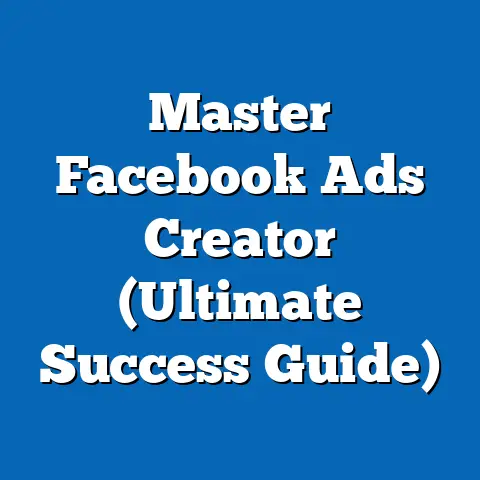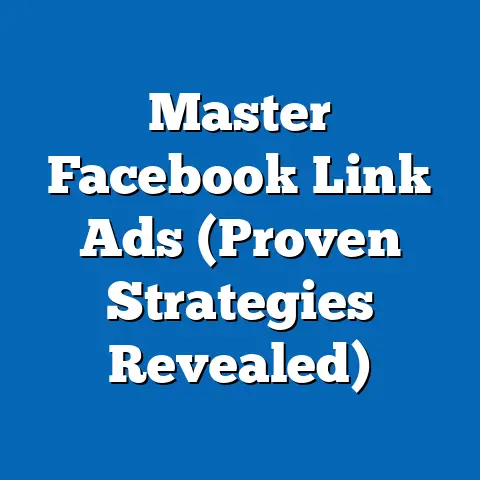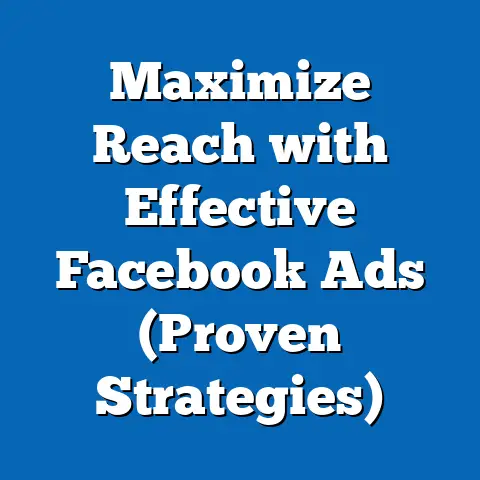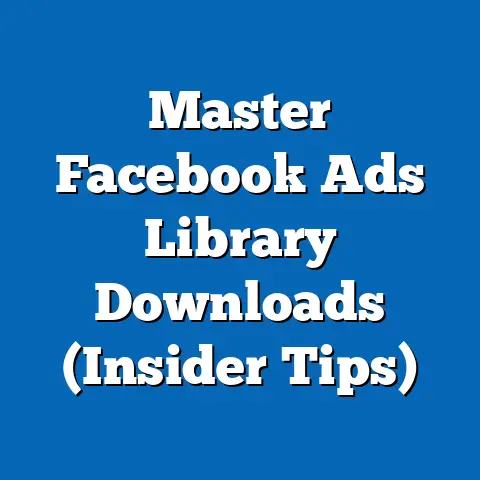Transform Facebook Ads Post-iOS 14 (Expert Strategies Revealed)
The digital advertising world was undeniably shaken by Apple’s iOS 14 update. The introduction of the App Tracking Transparency (ATT) framework, which fundamentally altered how user data could be accessed and tracked, sent ripples throughout the industry, particularly impacting Facebook advertisers. What once felt like a predictable ecosystem, where precise targeting was almost a given, suddenly became a landscape demanding agility and innovation. The ability to track users across apps and websites, a cornerstone of targeted advertising, was now largely in the hands of the user, with the vast majority opting out of tracking.
This shift has forced us, as marketers, to rethink our strategies. The effectiveness of traditional Facebook ad campaigns, heavily reliant on granular user data, has been significantly affected. We’ve had to become more creative, more strategic, and more data-driven in our approaches. Budgeting, in particular, has taken on a new level of importance. It’s no longer just about allocating funds; it’s about allocating them smartly, efficiently, and with a keen understanding of the limitations and opportunities presented by the post-iOS 14 world. In this article, I’ll share my expert strategies, honed through real-world experience and constant adaptation, to help you transform your Facebook ad campaigns and thrive in this new era.
Section 1: Understanding Budget Options in the Post-iOS 14 Landscape
Importance of Budgeting in Digital Advertising
Budgeting is the backbone of any successful Facebook ad campaign. It’s not just about setting aside money; it’s about strategically allocating resources to maximize your return on investment. A well-defined budget allows you to:
- Control Costs: Prevents overspending and keeps your advertising expenses aligned with your overall marketing goals.
- Optimize Performance: Enables you to test different strategies and ad formats, identify what works best, and allocate more funds to high-performing campaigns.
- Achieve Scalability: Provides a framework for scaling your campaigns effectively, ensuring that you’re not wasting money on inefficient tactics.
- Measure ROI: Allows you to accurately track your return on ad spend (ROAS) and make informed decisions about future investments.
In the post-iOS 14 landscape, the importance of budgeting has only intensified. With reduced targeting capabilities, every dollar counts even more. We need to be more precise with our spending, focusing on strategies that deliver the highest impact with the least amount of wasted ad spend. Adaptability is key. What worked before may not work now, and we need to be prepared to adjust our budgets based on real-time performance data and evolving market conditions.
Types of Budget Options
Facebook offers several budget options, each with its own set of advantages and disadvantages. Understanding these options is crucial for making informed decisions about how to allocate your ad spend.
-
Daily Budget vs. Lifetime Budget:
- Daily Budget: This is the average amount you’re willing to spend on your ad set each day. Facebook will try to spend this amount, but it may fluctuate slightly based on performance and audience availability.
- Advantages: Provides consistent spending throughout the day, allowing you to reach your target audience at various times. It’s good for ongoing campaigns where you want continuous exposure.
- Disadvantages: Can be less efficient if certain times of the day or days of the week perform better than others.
- Lifetime Budget: This is the total amount you’re willing to spend on your ad set over its entire duration. Facebook will optimize your spending to get the best results within this budget.
- Advantages: Allows Facebook’s algorithm more flexibility to optimize your ad delivery, potentially leading to better results. It’s good for campaigns with a specific end date, like a promotion or event.
- Disadvantages: Can lead to uneven spending, with Facebook potentially spending more on certain days or times than others.
In the post-iOS 14 environment, the choice between daily and lifetime budgets depends on your specific goals and campaign strategy. If you’re running a long-term branding campaign, a daily budget might be more suitable for consistent exposure. However, if you’re running a short-term campaign with a specific goal, a lifetime budget might allow Facebook’s algorithm to optimize your spending more effectively.
- Daily Budget: This is the average amount you’re willing to spend on your ad set each day. Facebook will try to spend this amount, but it may fluctuate slightly based on performance and audience availability.
-
Campaign Budget Optimization (CBO):
- What is CBO? CBO allows you to set a single budget at the campaign level, and Facebook will automatically distribute that budget across your ad sets based on their performance. This means that the ad sets that are delivering the best results will receive more of the budget, while those that are underperforming will receive less.
- How it Works: You set a campaign budget, and Facebook uses its algorithm to determine which ad sets are most likely to achieve your desired outcome. It then allocates more of the budget to those ad sets, constantly adjusting the distribution based on real-time performance data.
- Importance in the Post-iOS 14 Landscape: With reduced audience targeting capabilities, CBO becomes even more crucial. It allows Facebook’s algorithm to identify the most effective ad sets and allocate your budget accordingly, even with less data to work with. This can help you maximize your ROI and ensure that you’re not wasting money on underperforming campaigns.
I’ve personally found CBO to be incredibly valuable in the post-iOS 14 era. It takes some of the guesswork out of budget allocation and allows Facebook’s algorithm to do what it does best: optimize for results. However, it’s important to note that CBO requires a certain level of trust in Facebook’s algorithm. You need to be comfortable giving up some control over your budget allocation and allowing Facebook to make decisions on your behalf.
Daily Budget vs. Lifetime Budget:
- Daily Budget: This is the average amount you’re willing to spend on your ad set each day. Facebook will try to spend this amount, but it may fluctuate slightly based on performance and audience availability.
- Advantages: Provides consistent spending throughout the day, allowing you to reach your target audience at various times. It’s good for ongoing campaigns where you want continuous exposure.
- Disadvantages: Can be less efficient if certain times of the day or days of the week perform better than others.
- Lifetime Budget: This is the total amount you’re willing to spend on your ad set over its entire duration. Facebook will optimize your spending to get the best results within this budget.
- Advantages: Allows Facebook’s algorithm more flexibility to optimize your ad delivery, potentially leading to better results. It’s good for campaigns with a specific end date, like a promotion or event.
- Disadvantages: Can lead to uneven spending, with Facebook potentially spending more on certain days or times than others.
- Advantages: Provides consistent spending throughout the day, allowing you to reach your target audience at various times. It’s good for ongoing campaigns where you want continuous exposure.
- Disadvantages: Can be less efficient if certain times of the day or days of the week perform better than others.
- Advantages: Allows Facebook’s algorithm more flexibility to optimize your ad delivery, potentially leading to better results. It’s good for campaigns with a specific end date, like a promotion or event.
- Disadvantages: Can lead to uneven spending, with Facebook potentially spending more on certain days or times than others.
In the post-iOS 14 environment, the choice between daily and lifetime budgets depends on your specific goals and campaign strategy. If you’re running a long-term branding campaign, a daily budget might be more suitable for consistent exposure. However, if you’re running a short-term campaign with a specific goal, a lifetime budget might allow Facebook’s algorithm to optimize your spending more effectively.
Campaign Budget Optimization (CBO):
- What is CBO? CBO allows you to set a single budget at the campaign level, and Facebook will automatically distribute that budget across your ad sets based on their performance. This means that the ad sets that are delivering the best results will receive more of the budget, while those that are underperforming will receive less.
- How it Works: You set a campaign budget, and Facebook uses its algorithm to determine which ad sets are most likely to achieve your desired outcome. It then allocates more of the budget to those ad sets, constantly adjusting the distribution based on real-time performance data.
- Importance in the Post-iOS 14 Landscape: With reduced audience targeting capabilities, CBO becomes even more crucial. It allows Facebook’s algorithm to identify the most effective ad sets and allocate your budget accordingly, even with less data to work with. This can help you maximize your ROI and ensure that you’re not wasting money on underperforming campaigns.
I’ve personally found CBO to be incredibly valuable in the post-iOS 14 era. It takes some of the guesswork out of budget allocation and allows Facebook’s algorithm to do what it does best: optimize for results. However, it’s important to note that CBO requires a certain level of trust in Facebook’s algorithm. You need to be comfortable giving up some control over your budget allocation and allowing Facebook to make decisions on your behalf.
Setting Realistic Budgets
Setting a realistic budget is a critical step in any Facebook ad campaign. It’s not just about pulling a number out of thin air; it’s about carefully considering your goals, target audience, and historical performance data. Here are some tips for setting realistic budgets:
- Define Your Goals: What do you want to achieve with your Facebook ad campaign? Are you trying to generate leads, drive sales, or increase brand awareness? Your goals will directly impact your budget.
- Understand Your Target Audience: Who are you trying to reach? The size and characteristics of your target audience will influence your budget.
- Analyze Historical Data: Look at your past Facebook ad campaigns to see what worked and what didn’t. How much did you spend, and what were your results? This data can provide valuable insights into how much you should budget for future campaigns.
- Competitor Benchmarking: Research what your competitors are spending on Facebook ads. This can give you a sense of the industry average and help you determine a competitive budget.
- Start Small and Scale: Don’t be afraid to start with a small budget and gradually scale up as you see results. This allows you to test different strategies and optimize your campaigns before committing to a large investment.
In the post-iOS 14 landscape, historical data analysis is more important than ever. We need to rely on our own data to inform our budget decisions, as external data sources are becoming less reliable. I recommend focusing on first-party data, such as website traffic, customer lists, and email engagement, to understand your audience and their behavior.
Adjusting Budgets Based on Performance
Once you’ve set your budget, it’s important to continuously monitor and adjust it based on campaign performance. This is not a set-it-and-forget-it situation. The digital advertising landscape is constantly evolving, and you need to be prepared to adapt your budget as needed.
-
Key Performance Indicators (KPIs) to Track:
- Cost Per Acquisition (CPA): The amount you spend to acquire a new customer.
- Return on Ad Spend (ROAS): The revenue you generate for every dollar you spend on advertising.
- Click-Through Rate (CTR): The percentage of people who see your ad and click on it.
- Conversion Rate: The percentage of people who click on your ad and complete a desired action, such as making a purchase or filling out a form.
- Customer Lifetime Value (CLV): The total revenue you expect to generate from a customer over their entire relationship with your business.
-
How to Adjust Budgets:
- Increase Budget for High-Performing Campaigns: If a campaign is delivering strong results, consider increasing the budget to scale your reach and generate even more conversions.
- Decrease Budget for Underperforming Campaigns: If a campaign is not performing well, consider decreasing the budget or pausing it altogether.
- Test Different Budget Levels: Experiment with different budget levels to see how they impact your results. You might find that a slightly higher budget can significantly improve your performance.
- Monitor Trends and Adjust Accordingly: Keep an eye on industry trends and adjust your budget based on what’s working for other advertisers.
I’ve found that setting up automated rules in Facebook Ads Manager can be a helpful way to manage my budgets. For example, I can set up a rule that automatically increases the budget for a campaign if it achieves a certain ROAS, or pauses a campaign if it exceeds a certain CPA. This allows me to optimize my budget in real-time, without having to constantly monitor my campaigns manually.
Key Performance Indicators (KPIs) to Track:
- Cost Per Acquisition (CPA): The amount you spend to acquire a new customer.
- Return on Ad Spend (ROAS): The revenue you generate for every dollar you spend on advertising.
- Click-Through Rate (CTR): The percentage of people who see your ad and click on it.
- Conversion Rate: The percentage of people who click on your ad and complete a desired action, such as making a purchase or filling out a form.
- Customer Lifetime Value (CLV): The total revenue you expect to generate from a customer over their entire relationship with your business.
How to Adjust Budgets:
- Increase Budget for High-Performing Campaigns: If a campaign is delivering strong results, consider increasing the budget to scale your reach and generate even more conversions.
- Decrease Budget for Underperforming Campaigns: If a campaign is not performing well, consider decreasing the budget or pausing it altogether.
- Test Different Budget Levels: Experiment with different budget levels to see how they impact your results. You might find that a slightly higher budget can significantly improve your performance.
- Monitor Trends and Adjust Accordingly: Keep an eye on industry trends and adjust your budget based on what’s working for other advertisers.
I’ve found that setting up automated rules in Facebook Ads Manager can be a helpful way to manage my budgets. For example, I can set up a rule that automatically increases the budget for a campaign if it achieves a certain ROAS, or pauses a campaign if it exceeds a certain CPA. This allows me to optimize my budget in real-time, without having to constantly monitor my campaigns manually.
Takeaway: Understanding your budget options and continuously adjusting your spending based on performance is crucial for success in the post-iOS 14 landscape. Focus on setting realistic budgets, analyzing historical data, and tracking key performance indicators to maximize your ROI.
Section 2: Expert Strategies for Facebook Ads in a Post-iOS 14 World
Refined Targeting Techniques
With the limitations imposed by iOS 14, the “spray and pray” approach to targeting is no longer viable. We need to be more strategic and refined in our targeting techniques. Here are some strategies that I’ve found to be effective:
- Custom Audiences: These are audiences that you create based on your own data, such as website traffic, customer lists, and email engagement. Custom Audiences are a powerful way to target people who have already interacted with your business, making them more likely to convert.
- Lookalike Audiences: These are audiences that Facebook creates based on your Custom Audiences. Facebook analyzes the characteristics of your Custom Audience and finds other people who are similar to them. Lookalike Audiences can be a great way to expand your reach and find new customers who are likely to be interested in your products or services.
-
First-Party Data: This is data that you collect directly from your customers, such as their email addresses, phone numbers, and purchase history. First-party data is becoming increasingly valuable in the post-iOS 14 landscape, as it’s not subject to the same privacy restrictions as third-party data.
I’ve found that leveraging first-party data is essential for success in the post-iOS 14 era. By focusing on people who have already shown an interest in your business, you can increase your chances of conversion and maximize your ROI. For example, I’ve used customer lists to create Custom Audiences and target them with special offers and promotions. This has been a highly effective way to drive sales and increase customer loyalty.
First-Party Data: This is data that you collect directly from your customers, such as their email addresses, phone numbers, and purchase history. First-party data is becoming increasingly valuable in the post-iOS 14 landscape, as it’s not subject to the same privacy restrictions as third-party data.
I’ve found that leveraging first-party data is essential for success in the post-iOS 14 era. By focusing on people who have already shown an interest in your business, you can increase your chances of conversion and maximize your ROI. For example, I’ve used customer lists to create Custom Audiences and target them with special offers and promotions. This has been a highly effective way to drive sales and increase customer loyalty.
Creative and Engaging Ad Formats
In a world where users are bombarded with ads, it’s more important than ever to create ads that are creative, engaging, and stand out from the crowd. Here are some ad formats that I’ve found to be particularly effective:
- Video Ads: Video ads are a great way to capture attention and tell a story. They can be used to showcase your products or services, share customer testimonials, or simply entertain your audience.
- Carousel Ads: Carousel ads allow you to showcase multiple products or services in a single ad. This is a great way to highlight your range of offerings and give users more options to choose from.
-
Collection Ads: Collection ads are similar to carousel ads, but they’re designed specifically for e-commerce businesses. They allow you to showcase your products in a visually appealing way and make it easy for users to purchase them directly from the ad.
I’ve found that video ads are particularly effective for driving engagement and brand awareness. By creating high-quality videos that resonate with your target audience, you can capture their attention and leave a lasting impression. For example, I’ve created video ads that showcase our company culture and values. This has helped us attract top talent and build a strong brand reputation.
Collection Ads: Collection ads are similar to carousel ads, but they’re designed specifically for e-commerce businesses. They allow you to showcase your products in a visually appealing way and make it easy for users to purchase them directly from the ad.
I’ve found that video ads are particularly effective for driving engagement and brand awareness. By creating high-quality videos that resonate with your target audience, you can capture their attention and leave a lasting impression. For example, I’ve created video ads that showcase our company culture and values. This has helped us attract top talent and build a strong brand reputation.
Leveraging Facebook’s Algorithm
Facebook’s algorithm is constantly evolving, and it’s important to stay up-to-date on the latest changes. Here are some tips for leveraging the algorithm to your advantage:
- Ad Relevance: Facebook rewards ads that are relevant to the user’s interests and needs. Make sure your ads are targeted to the right audience and that your messaging is clear and concise.
- Engagement Rates: Facebook also rewards ads that generate high engagement rates, such as likes, comments, and shares. Create ads that are designed to encourage interaction and spark conversation.
-
Ad Quality: Facebook considers the quality of your ads when determining which ads to show to users. Make sure your ads are visually appealing, well-written, and free of errors.
I’ve found that focusing on ad relevance is the key to success with Facebook’s algorithm. By targeting the right audience with the right message, you can increase your chances of getting your ads seen and generating conversions. For example, I’ve created different ad campaigns for different segments of our target audience, each with its own unique messaging and creative. This has helped us improve our ad relevance scores and drive better results.
Ad Quality: Facebook considers the quality of your ads when determining which ads to show to users. Make sure your ads are visually appealing, well-written, and free of errors.
I’ve found that focusing on ad relevance is the key to success with Facebook’s algorithm. By targeting the right audience with the right message, you can increase your chances of getting your ads seen and generating conversions. For example, I’ve created different ad campaigns for different segments of our target audience, each with its own unique messaging and creative. This has helped us improve our ad relevance scores and drive better results.
Diversification of Ad Placements
Facebook offers a variety of ad placements, including Facebook, Instagram, and the Audience Network. Diversifying your ad placements can help you reach a wider audience and maximize your engagement.
- Facebook: The most popular ad placement, offering a wide range of targeting options and ad formats.
- Instagram: A visually-driven platform that’s popular with younger audiences.
-
Audience Network: A network of websites and apps that allow you to extend your reach beyond Facebook and Instagram.
I recommend testing different ad placements to see what works best for your business. For example, you might find that Instagram is more effective for driving brand awareness, while Facebook is more effective for driving sales.
Audience Network: A network of websites and apps that allow you to extend your reach beyond Facebook and Instagram.
I recommend testing different ad placements to see what works best for your business. For example, you might find that Instagram is more effective for driving brand awareness, while Facebook is more effective for driving sales.
Utilizing Retargeting Strategies
Retargeting is a powerful strategy for re-engaging users who have previously interacted with your business. By targeting users who have visited your website, watched your videos, or engaged with your ads, you can increase your chances of conversion and drive sales.
- Website Retargeting: Target users who have visited your website with ads that promote your products or services.
- Video Retargeting: Target users who have watched your videos with ads that encourage them to take the next step, such as visiting your website or making a purchase.
-
Engagement Retargeting: Target users who have engaged with your ads with ads that offer special discounts or promotions.
I’ve found that retargeting is particularly effective for driving sales. By targeting users who have already shown an interest in your products or services, you can increase your chances of converting them into customers. For example, I’ve created retargeting campaigns that offer special discounts to users who have abandoned their shopping carts. This has helped us recover a significant percentage of lost sales.
Engagement Retargeting: Target users who have engaged with your ads with ads that offer special discounts or promotions.
I’ve found that retargeting is particularly effective for driving sales. By targeting users who have already shown an interest in your products or services, you can increase your chances of converting them into customers. For example, I’ve created retargeting campaigns that offer special discounts to users who have abandoned their shopping carts. This has helped us recover a significant percentage of lost sales.
Takeaway: In the post-iOS 14 world, it’s more important than ever to be strategic and refined in your Facebook ad strategies. Focus on refining your targeting techniques, utilizing creative and engaging ad formats, leveraging Facebook’s algorithm, diversifying your ad placements, and utilizing retargeting strategies to maximize your ROI.
Section 3: Measuring Success and Iterating on Strategies
Importance of Analytics Post-iOS 14
In the post-iOS 14 landscape, analytics are more crucial than ever. With reduced data tracking, it’s essential to rely on robust analytics to measure your success and identify areas for improvement.
- Facebook Ads Manager: Facebook Ads Manager provides a wealth of data about your ad campaigns, including impressions, clicks, conversions, and cost per acquisition.
-
Third-Party Analytics Tools: There are many third-party analytics tools that can provide additional insights into your ad performance, such as Google Analytics, Mixpanel, and Amplitude.
I recommend using a combination of Facebook Ads Manager and third-party analytics tools to get a complete picture of your ad performance. By tracking your results closely, you can identify what’s working and what’s not, and make adjustments to your strategies accordingly.
Third-Party Analytics Tools: There are many third-party analytics tools that can provide additional insights into your ad performance, such as Google Analytics, Mixpanel, and Amplitude.
I recommend using a combination of Facebook Ads Manager and third-party analytics tools to get a complete picture of your ad performance. By tracking your results closely, you can identify what’s working and what’s not, and make adjustments to your strategies accordingly.
Key Metrics to Monitor
Here are some key metrics that I recommend monitoring in the post-iOS 14 landscape:
- Click-Through Rate (CTR): The percentage of people who see your ad and click on it.
- Conversion Rate: The percentage of people who click on your ad and complete a desired action, such as making a purchase or filling out a form.
- Cost Per Acquisition (CPA): The amount you spend to acquire a new customer.
-
Customer Lifetime Value (CLV): The total revenue you expect to generate from a customer over their entire relationship with your business.
By tracking these metrics closely, you can identify areas where you can improve your ad performance and maximize your ROI. For example, if you notice that your CTR is low, you might need to improve your ad creative or targeting. If you notice that your CPA is high, you might need to optimize your landing page or ad copy.
Customer Lifetime Value (CLV): The total revenue you expect to generate from a customer over their entire relationship with your business.
By tracking these metrics closely, you can identify areas where you can improve your ad performance and maximize your ROI. For example, if you notice that your CTR is low, you might need to improve your ad creative or targeting. If you notice that your CPA is high, you might need to optimize your landing page or ad copy.
A/B Testing for Continuous Improvement
A/B testing is a powerful strategy for optimizing your ad performance. By testing different versions of your ads, you can identify what works best and make improvements to your strategies.
-
What to Test:
- Ad Creative: Test different images, videos, and ad copy to see what resonates best with your target audience.
- Targeting: Test different targeting options to see which audiences are most likely to convert.
- Landing Pages: Test different landing pages to see which ones generate the most conversions.
-
How to Analyze Results:
- Track Key Metrics: Track the key metrics mentioned above to see how each version of your ad performs.
- Use Statistical Significance: Make sure your results are statistically significant before making any decisions. This means that the difference in performance between the two versions of your ad is unlikely to be due to chance.
- Iterate and Improve: Use the results of your A/B tests to iterate and improve your ad strategies.
I’ve found that A/B testing is essential for continuous improvement. By constantly testing new ideas and strategies, you can stay ahead of the curve and maximize your ROI.
What to Test:
- Ad Creative: Test different images, videos, and ad copy to see what resonates best with your target audience.
- Targeting: Test different targeting options to see which audiences are most likely to convert.
- Landing Pages: Test different landing pages to see which ones generate the most conversions.
How to Analyze Results:
- Track Key Metrics: Track the key metrics mentioned above to see how each version of your ad performs.
- Use Statistical Significance: Make sure your results are statistically significant before making any decisions. This means that the difference in performance between the two versions of your ad is unlikely to be due to chance.
- Iterate and Improve: Use the results of your A/B tests to iterate and improve your ad strategies.
I’ve found that A/B testing is essential for continuous improvement. By constantly testing new ideas and strategies, you can stay ahead of the curve and maximize your ROI.
Takeaway: In the post-iOS 14 landscape, analytics and A/B testing are essential for measuring your success and iterating on your strategies. Focus on tracking key metrics, using statistical significance, and continuously testing new ideas to maximize your ROI.
Conclusion
The iOS 14 update has undoubtedly changed the landscape of Facebook advertising. However, it’s not the end of the world. By adapting your budget strategies, refining your targeting techniques, utilizing creative ad formats, leveraging Facebook’s algorithm, diversifying your ad placements, and utilizing retargeting strategies, you can still thrive in this new era.
Remember, the key is to be agile, data-driven, and constantly learning. Embrace these strategies, experiment with new approaches, and never stop optimizing your campaigns. By doing so, you can transform your Facebook ad campaigns and achieve better results, even in the face of the challenges posed by the iOS 14 update. The future of Facebook advertising is not about relying on outdated tactics; it’s about embracing innovation and adapting to the ever-changing digital landscape. Now go out there and make some magic happen!





